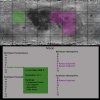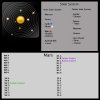Hydromancerx
C2C Modder
Can't believe this escaped my attention for two weeks.
A question first: is this mod supposed to start from the ancient era with tech progression towards the space exploration/colonization part, or does it start from the modern/future era?
In any case, good ideas here and the basics sound realistic. However, since the plan is to have a bit of a random solar system I wonder why you would restrict yourself to the standard 'habitable planet with a moon in orbit'. How about the home planet's location depend on the mapsize? For instance tiny/small sized maps could be considered a home'moon' orbiting on a safe distance (radiationwise) from a gas giant near or in the habitable zone of a sun. And the larger the size of the map, the more chance for multiple and large moons orbiting the homeworld (planet in this case). And dependent on the kind of star(s) in the system, there could be more then one planet in the habitable zone(s).
I've seen some discussion on whether or not other civs could also establish colonies on an already inhabited planet/moon. Whether or not this is allowed could be tied in the game as a UN-council proposal. Let's say the proposal becomes viable once the first civ created the Apollo Program. Same with space stuff that let large chunks of matter like asteroids or ice-comets be diverted in orbit of the homeworld. There's always the risk of miscalculation or technical problem nudging such stuff in orbit and let the whole thing crash downwards.
Of course, defying a proposal is an option, but penalties from the other civs might become more severe the higher the risk for the whole homeworld.
Some other thing. The habitability of a planet is of course mostly determined by the distance from its sun. But size could also play a role. For instance, I've read somewhere that if Venus and Mars where in each other's orbits their hospitality towards life would be increased significantly.
I cannot speak for Civ Fuehrer but I will do my best to answer the reasoning for my suggestions.
1. Yes I would like to have it track astronomical science throughout history, be it stargazing, astrology or even as recent has lunar exploration. In addition I would like to add a new era after the trans-human era called the "Intergalactic Era" which would involve the colonization of space beyond our solar system. Basiclly ...
Modern Era = Moon Colonization
Trans-Human Era = Home Solar System Colonization
Intergalactic Era = Colonization of Other Star Systems.
2. The main reason for starting everyone off with an Earth-like planet with at least one moon is so history nd in turn the tech tree stays the same. Orbiting a huge Gas Giant would change human history, culture and religion. In addition other factors play a part. One is having a moon gives us tides and protects us from asteroids. Note we also would have at least one gas giant in the solar system to attract asteroids to. If we were orbiting a gas giant we would risk being hit by asteroids all the time since the planet would pull more towards us. In addition our sun would stay the same. In short all of these factors that make Earth, how it is today is staying the same since changing it could result in a much diffrent Earth, evolution and civilization then we currently have.
3. I do like your ideas of map size effecting things. Perhaps map size could effect the number of planets/moons in the solar system to discover.
4. As for inhabiting a planet that's already occupied. I would say it would be free to set up bases on until all slots were filled up. beyond that you would probably have to fight them for the currently filled up spots. Such as using asteroid weapons to bombard their cities. Or the old send in the troops to invade method. Or heck maybe even just buy the city through trade negotiations.
5. I think the UN should eventually become obsolete for a Star Trek-like Federation of Planets since it will not just be nations on Earth but nations on planets/moons in the solar systems and beyond.
6. That's a good point. Planet habitation should be worked out. Especially when teraforming tech comes around and you could change its "T Score" to a more hospitable climate.









